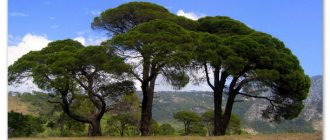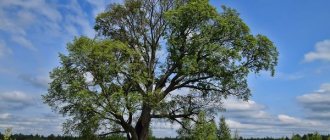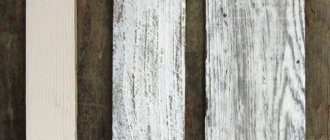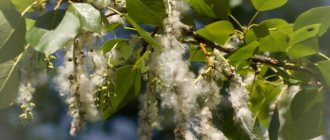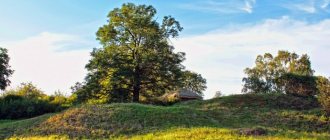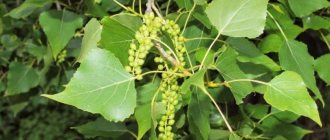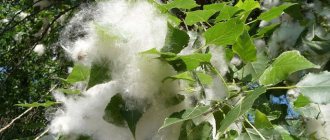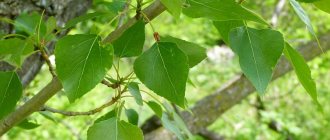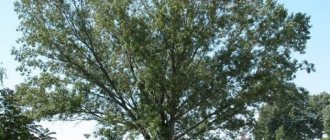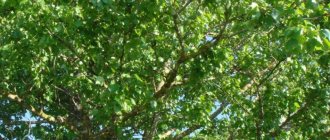White or silver poplar is a frost-resistant crop, characterized by fast growth, unpretentiousness and the ability to release huge amounts of oxygen, which is important for landscaping city streets and squares. Belongs to the willow family, growing everywhere. There is probably no place in our country now that is not decorated with monumental poplar landscapes, groves and alleys framed by representatives of this culture.
Other names
In botanical sources, the plant is designated by its official name “white poplar” or by its Latin equivalent Pópulus álba. But in everyday use this poplar is called silver, snow-white, false-white, which is justified by the color of the bark.
Did you know? According to ancient Roman mythology, the white poplar has been considered a sacred tree since the time of Hercules. Since then, when Cacus was defeated in a cave of a hill overgrown with these giants, poplar branches symbolize victory.
The plant is also commonly called "abele", which is an abbreviation of the Latin word "albellus", meaning "white". In some literature there are the names “Bolle poplar”, “Bachofen poplar” and Latin synonyms: White Poplar, Silverleaf Poplar, Silver Poplar.
Taxonomy
This majestic plant is a fast-growing deciduous tree belonging to the Poplar genus and Willow family. In a more detailed description of the white poplar taxon, botanists indicate the department of Flowering or Angiosperms of the order Malpighieceae.
In addition to white poplar, the Willow family also includes willow and its species: weeping, goat, dwarf, globular and whole-leaved.
Description of the tree
The characteristic features of the plant are its thick and tall light-colored trunk, wide pyramidal or rounded crown. These are well-known signs by which a tree is easily recognized. Let's take a closer look at its description.
Trunk, bark
The tree grows to a height of 16–30 m. Compared to the wide crown, which starts low to the ground, the trunk seems very short. Its maximum length is 1.5–2.5 m. At the base it is thick, and closer to the middle of the crown it branches into equal shoots.
Did you know? After three centuries of cultivation of white poplar, the plant was banned in the state of Connecticut. The reason for this was massive hay fever caused by down. Additionally, the tree is considered an environmental weed in many states.
Young seedlings have smooth bark, which rather resembles a smoky coating of felt. Mature trees are distinguished by a longitudinally fissured surface of the trunk that is light silver or slightly greenish in color. Old trees can be identified by deep cracks and dark bark that very often turns black.
Leaves
In spring, small egg-shaped leaf buds appear on the branches of white poplar. Moreover, on old branches they are bare and glossy, and on young ones they are covered with light pubescence. From them emerge foliage of various shapes. Some specimens may be delta-shaped, others may be oval, egg-shaped, multi-lobed. What unites this whole extravaganza of forms is the dense structure, size and color of the leaf plates. They are dark green and smooth above, and silvery-felt below. Closer to November, the foliage turns bright yellow, and may turn brown during the rainy season. But the peculiarity of Abele is that its leaf fall begins even when the crown is green. On average, each leaf reaches up to 12 cm in length and up to 10 cm in width. It is attached to the branch by a short cylindrical petiole.
Did you know? Depending on cultivation conditions and various environmental factors, poplar can change gender from female to male and vice versa.
Flowers
Depending on climatic conditions, the tree blooms in the last weeks of April–early May. Often this period coincides with the blossoming of leaves.
Among the inflorescences of the plant, which are catkins up to 8 cm long, botanists distinguish between male and female specimens. The former are characterized by a gray color and bright terracotta stamens, while the latter are characterized by a green-gray color. In addition, trees with female flowers are allergens. After pollination, seeds are formed, which are fully ripe by summer.
Fruit
The achenes have the shape of a narrow cone. In the first phases of development, they are distinguished by their bright green color and smooth structure. As they mature, their color acquires light brown shades. At the end of summer, the seed pods become completely dark. They clearly show a pair of valves, from which small grains with specific long fibers at the base spill out.
Root system
Typical characteristics of the silver poplar root system are power and growth. It develops depending on the physical and chemical characteristics of the soil. In humid areas, fibrous roots are located in the surface layers, and in loamy and sandy areas they go deep as far as possible, reaching moisture. Young shoots often appear at the bottom of the trunk. It can also be found at a fairly considerable distance - 20 m from the mother tree.
Poplar diseases
Ella Sokolova , Candidate of Agricultural Sciences
Poplar, despite some disadvantages of the breed, is widely used for landscaping. It is resistant to the conditions of the urban environment, decorative, grows quickly, and has protective properties. However, the possibilities of its use in plantings are often limited by infectious diseases.
Leaf diseases
Powdery mildew (caused by the fungus Uncinula adunca). Black and balsam poplars are affected. In early July, on both sides of the leaves, but mainly on the top, a white coating of mycelium appears with sporulation in the form of separate, then merging spots. Later, the fruiting bodies of the fungus are formed on the mycelium in the form of numerous scattered black dots.
Rust (pathogens are fungi of the genus Melampsora). The fungus M. populina affects all types of black and balsam poplars, larch, and various types of onions; M. tremulae – species of white poplar, larch, celandine, corydalis and other types of herbaceous plants. At the end of June - beginning of July, on the underside of the leaves of all types of poplar, and on the petioles of white ones, a summer sporulation of pathogens is formed, which looks like numerous small yellow or orange powdery pads protruding from under the epidermis. Later, autumn-winter sporulation of fungi develops, noticeable in the form of small dark brown scabs located singly or in groups on the upper side of the leaves, less often on the lower side.
Brown spot (caused by the fungus Marssonina populi). Various species and hybrids of black and balsam poplars are affected, but the disease is most common on balsam poplars. The first spots on the leaves appear in late May - early June. The spots are brown, grayish-brown, round, vague, sometimes not clearly defined. On spots on both sides of the leaf, but mainly on the top, sporulation of the fungus forms, which looks like small yellowish or whitish round or flat formations. With severe development of the disease, the affected leaves become completely covered with spots, dry out and fall off prematurely. Balsam poplars, which are the most susceptible to the disease, lose almost all their leaves at the end of July.
White spot (caused by the fungus Septoria populi). Black and balsam poplars are affected. In early summer, round or angular white spots with a thin dark brown rim appear on both sides of the leaves. On the upper side of the spots, sporulation of the pathogen forms in the form of clearly visible small black dots. With a high level of damage, numerous spots cover almost the entire surface of the leaf. Spotting of white poplars with similar symptoms is caused by the fungus Septoria candida.
Scab (caused by the fungus Pollaccia radiosa). White poplar and its hybrids are affected. At the beginning of summer, purple-brown, round or irregularly shaped spots of different sizes form on the upper side of the leaves. Later, a velvety olive-colored coating of mycelium with sporulation of the pathogen appears on the spots. With severe damage, individual spots merge, covering almost the entire surface of the leaves. Affected leaves become deformed, dry out and fall off. In addition to leaves, the disease affects young shoots, which turn black, dry out and bend into hooks, and sometimes break. On two- and three-year-old shoots, elongated oval cancerous wounds develop.
The massive spread of leaf diseases with a high level of damage leads to their premature fall and thinning of the crown, weakening of young plants and reduced growth, loss of decorativeness of poplar and a decrease in its protective functions in different types of plantings.
Necrosis-cancer diseases of trunks and branches
Brown cytosporic necrosis , or cytosporosis (caused by the fungus Cytospora chrysosperma). Various species and hybrids of poplar are affected. Brown fungal tissue, stroma, develops in the thickness of the cortex of necrotic areas. Later, sporulation of the pathogen is formed in it, which takes the form of numerous small conical tubercles protruding from breaks in the epidermis. Mature spores emerge on the surface of the bark in the form of golden-orange thin spirals, flagella, and drops.
Black cytospore necrosis , or cytosporosis (pathogen is the fungus Cytospora foetida). Various species and hybrids of topole are affected, including white, silver, Canadian, sedge, etc. In the thickness of the affected bark, sporulation of the fungus is formed, which on areas of trunks and branches with thin smooth bark is noticeable in the form of black rounded convex spots with a diameter of up to 2 mm. In spring, spores emerge on the surface of the bark and solidify in the form of blood-red drops or flagella. Freshly infected parts of trunks and branches emit a characteristic unpleasant, pungent herring odor.
Discosporium necrosis (caused by the fungus Discosporium populeum). Various species and hybrids of black and balsam poplars are affected. Initially, depressed oval-shaped necrotic areas up to several centimeters in diameter appear on the bark of trunks and branches. The affected areas are distinguished by a darker color of the bark, which becomes yellowish as it dies. Cancerous wounds appear on thick branches and trunks. On dying and dead areas of the bark, sporulation of the fungus is formed, which has the form of tubercles with a diameter of up to 2 mm. The spores emerging on the surface of the bark look like blackish-white or light olive flagella 2–4 mm long.
These necroses develop against the background of weakening of the poplar caused by various unfavorable factors (drought, prolonged flooding, freezing, air and soil pollution, violation of planting care rules).
Black , hypoxylonic cancer of aspen and poplar (pathogen is the fungus Hypoxylon mammatum). Different types of poplar are affected, but more often white poplar species and hybrids are affected. Later, black smearing fungal tissue, stroma, develops in the thickness of the affected cortex. In the stroma, groups of fruiting bodies of the pathogen are formed in the form of rather large stony grayish-black formations of a polygonal shape. After the affected bark falls off, non-stepped wounds extending along the trunks and branches, reaching 1.5 m in length, with wood covered with black stroma, become noticeable.
Nectria (stepped) canker of deciduous trees (caused by the fungus Neonectria galligena). A characteristic sign of the disease are oval or round wounds with clearly defined gradations. Wounds form on branches and along the entire length of the trunk, sometimes several on different sides. The disease causes gradual weakening of trees and leads to their partial dryness.
Wet ulcerative-vascular cancer , or brown mucus (pathogens are bacteria Pseudomonas cerasi, P. syringae). In spring, oval swellings appear on the trunks and branches, from which a transparent liquid flows, turning brown in the air. On trunks with cracked bark, the disease is detected by the presence of smudges. Later, characteristic weeping wounds form at the site of the swelling. With the active development of the disease, the wounds merge, often ringing the trunk for up to 1 m.
Necrosis-cancer diseases lead to weakening and drying out of poplar, reducing its decorative properties and protective functions. Cancer diseases contribute to the infection of trees with rot and reduce their resistance to windfall.
Rot diseases of roots and trunks
White sapwood (peripheral) rot of roots and trunks (causative agent - autumn honey fungus - Armillaria mellea). The rot is white, fibrous, with thin black lines. Under the bark of roots and trunks, white fan-shaped films of mycelium and dark brown, almost black branching cords - rhizomorphs - are formed. Damage to the roots leads to rapid drying out of trees and contributes to the formation of windfall.
White marbled heartwood-sapwood rot of trunks (the causative agent is the true tinder fungus - Fomes fomentarius). Rot develops in the lower and middle parts of the trunk, rising to a height of up to 10 m.
Yellowish-white core rot of trunks (causative agent - maple polypore - Oxyporus populinus). The affected part is separated from the healthy part by a greenish narrow ring. The rot is fissured, breaks up into thin plates, and is concentrated in the lower and middle parts of the trunk.
Red-brown prismatic core rot of trunks (causative agent - sulfur-yellow tinder fungus - Laetiporus sulphureus). Rot develops mainly in the lower part of the trunk and rises to a height of 5–8 m. Fruiting bodies are formed at the sites of infection and serve as a reliable sign of rot damage. In the absence of fruiting bodies, the presence of rot can be judged by hollows, dry sides, cancerous wounds and mechanical damage on the trunks.
Rot of trunks significantly reduces the resistance of trees to wind and the formation of windbreaks.
Measures to combat poplar diseases include a set of the following measures:
- systematic surveillance of the emergence and spread of diseases;
- using healthy planting material to create plantings;
- creating optimal conditions for the growth and development of plants, increasing their resistance to disease;
- pruning diseased and withered branches and then destroying them;
- elimination of sources of infection (fallen leaves and shoots);
- removal of dying and withered trees, windfall and windbreaks from plantations;
- in foci of leaf diseases, cytospora and discosporium necrosis, treating poplar during the growing season with fungicides approved for use for each specific type of disease.
Brown leaf spot Black cytospor necrosis Brown cytospor necrosis
Some features
In fact, silver poplar has many unique characteristics. Let's look at the most interesting of them.
Average height, width
These trees are considered by many to be giants. The tallest poplars reach 60 meters in height. In our latitudes, specimens below 19 m cannot be found. In this case, the diameter of the old trunk can reach two meters in width, and the crown stretches up to 35 m.
In urban environments, such features of white poplar are highly valued. After all, according to Peter Bulakh, Doctor of Biological Sciences at the National Botanical Garden named after N. N. Grishko of the National Academy of Sciences of Ukraine, the plant develops quickly and easily adapts to sudden temperature changes and growing conditions. In addition, due to upward-pointing branches and a highly elongated crown, space is saved and at the same time purification of large volumes of air polluted by automobile exhausts. The scientist says that poplar foliage is capable of absorbing even metal-containing dust and is the leader in the list of trees in terms of the intensity of atmospheric filtration.
Did you know? After poplar, the top three environmental purifiers include chestnuts and linden.
Growth rate
When you look at the tall poplars, it seems like they take forever to reach such heights. But it turns out that the intensity of growth in silver and other varieties is recorded only in the first fifty years. Older trees slow down their development, and after 10–20 years they stop growing altogether.
Once on fertile soils, the pyramidal silver poplar reaches its maximum height already at 25 years of age. From the moment of planting, it increases annually by 1 m and in width by 40 cm.
Now you can imagine the speed at which metabolic processes occur in the tissue fibers of wood. It is very viable and can be reborn even when the trunk breaks during a hurricane.
Lifespan
Lumberjacks often joke that trees live until they are used for firewood and planks. There is, of course, some truth in this dark humor. But if you do not take into account poplar fellings, then the lifespan of a poplar is measured in centuries. Today, scientists say that many trees that are more than 400 years old have survived, but there are also 600-year-old giants.
Important! Poplar trees do not like to compete for space for their roots, and are also characterized by aggressive spreading. That is why they are not recommended to be planted closer than 15 m from buildings. The root system of the plant is capable of destroying underground and drainage structures, as well as the foundations of buildings and drying out soils. Poplar becomes especially dangerous in clayey areas.
Growing conditions
Scientists constantly talk about the good survival rate of the silver species. Let's figure out what is most suitable for a crop for a comfortable growing season.
Distribution and habitat
Today, the Abel poplar is known without exaggeration on all continents. The tree can be seen in subtropical, Mediterranean, temperate continental and temperate climate zones. Its habitat is almost the entire territory of Eurasia, not including Scandinavia. Wild thickets are found near water bodies, in riverine forests, floodplains, oxbow lakes and valleys. In steppe zones, they are comfortable growing on slightly saline soils. And in rocky areas, these giants can climb thousands of meters above sea level.
They often coexist with moisture-loving black poplars, elms, alders, and tamarisks, but they can also be placed alone.
Soil, moisture requirements
The ideal place for the growth of unpretentious false white poplar is fertile, moist, light substrates with good drainage and neutral acidity. But in the absence of such a benefit, the plant can be content with slightly acidic and alkaline soils, tolerate arid sandstones, heavy loams, and will even find vitality in silt and rubble.
Important! The tree reacts very painfully to pruning branches.
The plant is completely satisfied by nearby rivers and lakes or groundwater. Moreover, the root system does not suffer at all from prolonged flooding. But the tree's drought resistance is average.
Lighting requirements
Perhaps this is the only categorical condition that is vital for a sun-loving tree. It loves a lot of ultraviolet light and needs it. It can adapt to partial shade, but in such conditions its growth will slow down. Although, judging by the size of the poplar, it is not threatened by shadow.
Frost resistance
Botanists note the plant’s high resistance to low temperatures. It can easily overwinter at -30°C.
Spruce, birch, larch, Siberian pine, aspen, juniper, willow, elm and oak, as well as white poplar, are frost-resistant trees that have the ability to withstand short frosts.
Poplar: description with photo, habit. Types and varieties of poplar in landscape design
White poplar (silver) (Populus alba)
White poplar is a large deciduous tree. It grows very quickly (especially in the first 20-25 years), but only on fertile and sufficiently moist soils. Tolerates soil salinity. Photophilous. Can grow in partial shade. Loves moist soils and tolerates prolonged flooding. Can tolerate dry conditions. Winter-hardy. It strengthens the banks of rivers and reservoirs well.
dark green, white-felt underneath
White poplar (silver) Nivea (Populus alba Nivea)
White poplar Nivea has silvery-white leaves that retain their color for a long time, without changing color much even in autumn. The growth rate is very fast. Winter-hardy, frost-hardy. Light-loving, but tolerates shady areas. Drought resistant. Prefers moist and fertile soils. Used in park and urban landscaping.
dark green, white-felt underneath
Pyramid poplar (Populus pyramidalis)
Pyramidal poplar has a very narrow crown. The branches come from the base of the trunk. With its monumental, pyramidal, dark green crown it gives a special, southern character to the landscape, reminiscent of slender, pyramidal cypress trees. Good for quickly creating green protective walls. Does not produce fluff. A very impressive tree in single, group, row and alley plantings.
dark green, white-felt underneath
Reproduction
It is very easy to get a new plant seedling. In tropical regions, this process is possible by seed, and in temperate climate zones, vegetative propagation of silver poplar is more common. It is carried out by cuttings or separating root shoots. Let's look into the intricacies in more detail.
Important! Poplar seeds lose their usefulness after a year. The best conditions for storing them are cold and low humidity.
If you love botanical experiments and are a fairly patient and optimistic person, then you can take risks with sowing grains. Just be prepared right away that they have the best germination immediately after collection. It is then that you need to prepare peat pots and sow.
This is done in a damp substrate. When sowing seeds outdoors, it is advisable to cover the bed with a thin layer of straw mulch without waiting for germination. The material will retain moisture and protect the grains from weathering and washing away by rain.
When seedlings appear, provide them with good lighting. After all, in the shade they will stretch out greatly, become thin and fragile. Such conditions can destroy the sprouts in the first days after germination.
Experts advise giving preference to the seedling method using peat pots or tablets. In this case, there will be no need to separate the young shoots into individual containers. But if this is not done, leaving poplar seedlings crowded into the garden bed, all efforts will be in vain. The idea will not succeed, since the tree’s root system does not like to compete for space, nutrition, moisture and sun.
Important! When cutting cuttings, make sure that each of them has 2-3 leaf buds.
Of the vegetative propagation methods, the easiest is cuttings.
To obtain a new seedling, you need to prepare planting material in March. This is usually done for mass plantings, so a whole bunch of apical branches are cut, after which they are tied and placed in a bouquet in a jar of water.
By the way, liquid is needed up to half the container. Then everything is put into the refrigerator until planting. As a rule, it occurs in the second ten days of April. The process itself consists of planting the blanks in such a way that two-thirds of them are underground, and one bud is always left in the above-ground part. In a month, small roots will appear. To do this, it is important to monitor the moisture in the soil.
Separation of root cuttings is a complex and troublesome procedure. It often ends in failure due to damage to the young seedling when separated from the mother root.
Interesting Facts
There are many interesting facts and events associated with this tree that made the plant not only legendary, but even mystical. It will be interesting to know the following:
- the oldest poplar has been growing in Ukraine for more than 200 years;
- in times of famine, a layer of wood from under the bark was added to food;
- the buds of the plant contain essential oils and are actively used in perfumery;
- trees love to change their gender.
We must not forget about the healing capabilities of poplar. In medicine they use:
- bark;
- seeds;
- kidneys
All components are capable of very effectively influencing individual internal organs of a person and the body as a whole, increasing immunity and carrying out excellent preventive activities.
Poplar is a multifunctional and very useful tree
It is important to skillfully use the gifts of nature
https://youtube.com/watch?v=X82lVdSNoOM
Poplar
Decorative forms
The beautiful non-standard green-silver coloring of the foliage and the light bark of the white poplar give it an unusual decorative appearance. The tree is beautiful in all seasons. That is why it is often used in landscape design to create compositions and frame alleys.
Did you know? Each hectare of fifteen-year-old Abele plantations produces more than 200 m³ of wood.
The tree fits beautifully into the architecture of water zones and can grow in combination with other plants that differ sharply in color or alone.
Among the most popular decorative forms of the silver variety are:
- globular (globosa) - is a medium-sized tree with branches densely spaced in the shape of a wide oval and small foliage;
- weeping (pendula) - characterized by a low trunk and drooping branches;
- Richard (Richardii) - characterized by a yellow coloring of a glossy surface;
- snow-white (var.nivea) - looks impressive due to the snow-white back side of the leaves, which contrast with the silver surface.
Where is the best place to use lumber?
It is not recommended to use poplar logs and beams for the construction of load-bearing structures due to the low strength of the material. However, inexpensive wood is actively used in the production of plywood, containers, and furniture panels. Soft wood makes excellent garden sculptures, carved elements, and decorative structures.
We invite you to familiarize yourself with the herb celandine medicinal properties
With the development of the technology of glued products, which compensates for a number of shortcomings of the material, poplar began to be used in the production of furniture in combination with natural veneer of valuable species. But such a practice has so far only been developed abroad.
Application and properties
White poplar is not only a spectacular decoration of large parks and coastal areas, but also an excellent honey plant, a healing agent for people and animals, and also a valuable building material. Let's find out in detail what is the secret of the uniqueness of the plant.
Landscape qualities
In megacities, the compactness of the volumetric crown is valued. The plant is often used as fire protection and strengthening of coastal zones. This is facilitated by the high resistance of the crop to strong sea winds. But, unfortunately, this ability deteriorates after reaching the age of ten.
People have learned to take advantage of the aggressiveness of the white poplar roots. That is why it can often be seen on sand dunes near bodies of water.
Important! When mass planting silver poplar varieties, it is recommended to maintain a distance between trunks of 3 m, and for multi-row layouts, this should be the row spacing, and a new seedling is planted after 5 m.
Medicinal properties
If you take the entire silver poplar tree, its foliage, bast and outer layers of wood are considered edible. According to scientists, the leaf blades are valuable because they contain vitamin C, dried bast can be added to flour for baking bread, and the bark relieves pain, inflammatory processes, and has a disinfectant, diuretic, astringent and tonic effect.
Salicylates were found in the surface parts of the poplar trunk, which are the active ingredients of many painkillers, including aspirin.
Pharmacology widely uses the bark of the plant to produce a number of medications for rheumatism, gout, arthritis, lumbar pain, digestive tract dysfunction, fever, anorexia, menstrual pain, and general weakening of the body.
Traditional medicine recommends many recipes using poplar raw materials for the treatment of purulent non-healing wounds, abscesses, oral diseases, hemorrhoids and frostbite.
Important! Some vegetable growers advise using a cold extract from the leaves and young branches of white poplar as a growth stimulator. The solution is made by soaking finely chopped raw materials in plain water for 24 hours.
Honey plant
When a poplar tree blooms, bees flock from everywhere to its branches. The fact is that the tree gives a good supply of pollen. Beekeepers note that in terms of honey-bearing characteristics, silver poplar is only slightly inferior to linden. Pollen is spread from male to female by the wind. And although during the flowering period many people grumble, complaining about allergies caused by poplar fluff, it is absolutely impossible to get rid of the tree. Ecologists, bee colony owners, and herbalists talk about this.
Alphabetical index of plants from “A” to “Z”
Use the alphabetical index of plants for landscape design to view a catalog created by our specialists of several hundred varieties of plants used by designers in landscape projects for landscaping and landscaping, photographs of trees and shrubs, descriptions of their varieties and varieties, color, flowering, habit, crown height and diameter depending on the age of the plants. Examples of using plants from the catalogue, dendrological plans and projects of decorative groups can be found in the portfolio of landscape projects.
You can also use the plant catalog search.
